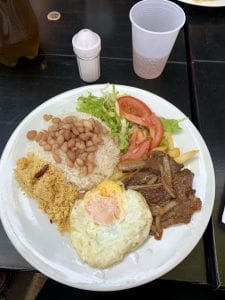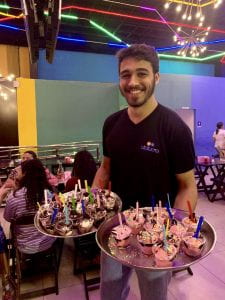Oi! I am reporting on the rest of my first week here in Campo Grande, Brazil, and a few of the highlights from my time here. As promised, I will talk a bit about the urban indigenous community, the Terena tribe, the Quilombos and a public high school where I visited and spoke with a classroom full of excited kids. I also want to talk a bit about the food I have been eating here, because wow! Brazil has some delicious things to eat.
Ok, so if you have been following the news, you will know that the indigenous people of Brazil are facing major challenges and uncertainty due to President Bolsonaro’s siding with agricultural farmers who want to increase deforestation with total disregard for the people who live there. Bolsonaro has voiced intentions of integrating indigenous people into mainstream society, which is not what indigenous groups want. From what I’ve learned, all they want is to live in nature, and they don’t care about money. You may have heard recently that a massive fire is burning in the Amazon rainforest, and many people believe this is due to farmers attempting to clear space for more farmland. I’m including a photo of our class with the urban indigenous group we met with. The interesting thing about them is that they are maintaining their culture within an urban setting. Generations of families live together in each home, and the Terena tribe own several blocks around the building we were invited into. They were also gracious enough to show some of their family wearing traditional clothing and even performed some dances for and with us! It was a wonderful experience that I feel so thankful to the Terena for inviting us into.
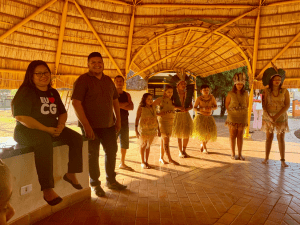
Next, I want to talk about the visit to Furnas Dionisio, a Quilombo community. But first, I’ll provide a mini explanation of who the Quilombo are. When Brazil was colonized by the Portuguese, about 4.8 million African slaves were brought to the country. Some of these people escaped and started communities in remote and difficult to access places. After abolition in 1888, some of these groups were discovered. Some were also granted land titles, though some still fight to this day to receive land and recognition.
The Furnas Dionisio Quilombo is a fairly self-sufficient community. They maintain some traditional practices, such as making a candy out of sugar cane that they grow, called rapadura. The rapadura is made in several flavors like ginger and banana, but my favorite was the leite, or milk candy with peanuts. They make and sell the sugar and molasses as well. I am including a video of the machine that processes the sugar cane and makes the pure sugar liquid, known as garapa. The garapa is then boiled in a reduction process, which is how the molasses and sugar are made. It was so interesting getting to see the different phases of the production process!
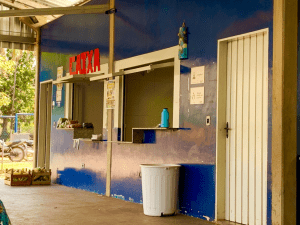
One of the days, I volunteered along with a few of my classmates to meet some high school students at The Maria Costança School. I had no idea what to expect but was asked to bring a show-and tell item to share with the students. I brought a couple of wallets I made for my handbag business, but I never even got a chance to share them, as the students had a million questions to ask me. They wanted to know why I came to Brazil, what I liked about their culture from the food to the music. When I asked for their suggestions on what Brazilian music to listen to, I was given about a dozen suggestions. The students were so excited to share their culture with me, and to learn about mine. They asked about my tattoos, and I shared about my past and connection to human rights issues. At one point, I told them about singing in bands and they looked up my band immediately, so now I think I have some fans in Brazil. We talked about our presidents and had a mutual agreement about them. By the end of the class, I was given a huge applause, and many hugs and kind words. One student even made me a wire sculpture of my name, and I was thoroughly touched. These kids were amazing! They are so full of life and passion. I could talk so much more about the inequality of the education system, but for now I will just say that these kids deserve big opportunities to obtain higher education and careers that match the fire I see within them. Below is a photograph of me with some of the students I met with! <3
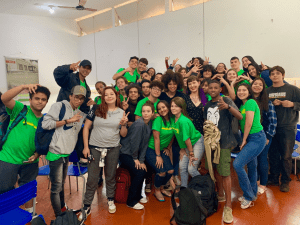
As promised, I am also including photos of some of the food I got to eat. In Brazil, lunch is the biggest meal of the day and usually consists of a meat, beans, rice, farina (fried mandioche flour), and salad. Another popular cuisine in Brazil is called Rodizio. Rodizio is a style of eating that is sort of like a buffet, except that servers come to you with platters of food. There are many types of rodizio, but the main ones are barbecue, sushi, and comfort food like burgers and pizzas- all with lots of cheese. I got to try the sushi rodizio and was very impressed! And just like most things in Brazil, Brazilians do traditional foods with their own twist. For example, I had never had sushi with mustard on top, but found it was actually pretty good!
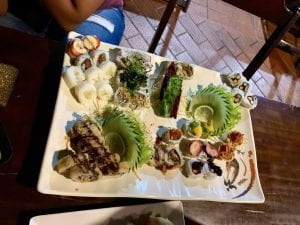
Anyway, those are some of the major highlights of this week. I hope you’ve enjoyed reading about my adventures so far. Also, if you’re interested, thisstudy abroad program is offered every year and I highly encourage you to sign up for this amazing opportunity to experience Brazil in a unique and wonderful way. With that, I wish you farewell until next time…..
Jessy
